What is “fine woodworking,” anyway?
The job was challenging, the client is happy, and Nancy Hiller learned a few things along the way. That's "fine" enough for us.
Over my nearly-40-year career as a furniture maker I’ve been aware of a hierarchy among woodworkers of different stripes. Although my formal training was in traditional furniture making through England’s City & Guilds of London system, my first job in the trade was for a designer of kitchens, who hired me to build cabinets (and their related moldings—cornices, beading to pin into door frames, beaded backboards, etc.) that would be installed by others. I was soon apprised of the social difference between myself as a cabinetmaker—a term that has traditionally encompassed those who make fine furniture in addition to what we in the States know as cabinetry—and the carpenters who worked on job sites; while I was generally at a disadvantage as a woman in a traditionally male field in rural England of the 1980s, my identity as a cabinetmaker put me on a higher standing than that of carpenters, as cabinetmaking entailed work of greater refinement. So, you know, there was that.
But it didn’t take me long to question this prejudice. After all, my cabinetry and furniture would have had nowhere to go, had it not been for the carpenters who had framed our clients’ buildings, then fitted them with floorboards, trim, and doors. The carpenters’ work seems pretty important in the end, and eminently worthy of respect. Yet the same prejudice remains widespread today, and it’s not uncommon for carpenters to retrain as furniture makers, seeking satisfaction and status from work that’s more refined.
I sometimes encounter a similar superciliousness among those who deem built-ins of any type a species of work inferior to fine furniture—when it comes to Americans, this applies especially to furniture based on original pieces produced during the golden age of East Coast furniture making, from the late 18th through early 19th century. I get it, of course. A variety of factors are at play, among them the following:
- The rarity of the clientele. Is your client someone famous or super-wealthy (give yourself 90 – 100 points on the maker-status scale), or someone more like you (that would be anywhere from zero to, like, 65 points if we’re being generous)?
- The purpose of the piece. Is it being made primarily as a status symbol (go to the top of the maker-status scale!), or to be used on a daily basis (so … you’re slumming it)?
- The rarity of the materials. Are you using common stuff like domestic hardwoods (cherry, maple, oak), or rare materials (ebony, leopardwood)? (Let’s give the common stuff 40 to 70 points here—I mean, at least it’s not finger-jointed pine! and it does have the virtue of being generally more sustainable, for a variety of reasons I won’t go into here—vs. somewhere between 95 and 100 for the rare.)
- The refinement of the work. Are you fitting delicately dovetailed drawers on wooden web frames hand-dadoed into solid Carpathian walnut cabinet sides (100 points, for sure), or do your drawers slide on mechanical drawer slides fastened to cabinet-grade plywood carcase walls assembled with screws and Domino tenons (unspeakably boorish)?
As someone who designs and builds furniture for a living and is not supported by family wealth or retired from a career in pharma or finance, I’m beyond over the snobbery. I do a variety of work and am grateful for it all. The job I just completed provides a great illustration of why I love my work, regardless of where I might rank on anyone else’s scale.

When the customer, Jeff, first got in touch, he wondered whether I would do something as basic as modify a pantry; he mentioned red oak plywood. He seemed to think it might be beneath a person of my skills. We’re acquaintances, having met through mutual friends, so that was a preliminary point in favor of saying yes, if only to be helpful. Also factor in that he contacted me shortly after the media had just been flooded with news of a recession; with PTSD from the 2007-2009 recession, I was even more primed to say yes to paid work of any kind. I had in mind plywood shelves—perhaps on pull-out hardware for easier access. We scheduled a meeting, with masks. And that was when I realized the job would be far more interesting, as well as challenging, than Jeff had given me to imagine.
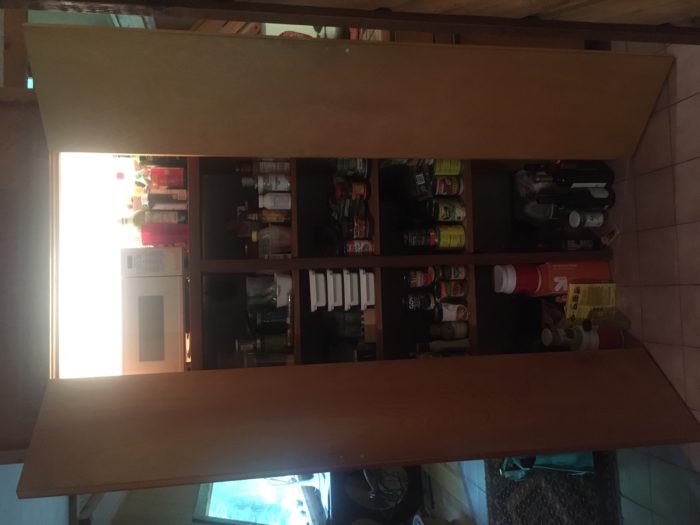
Not long after we started discussions, Jeff showed me a sketch of what he wanted. The idea was to match the look of his existing cabinetry pretty closely, though with domestic instead of tropical species for the pulls. As a woodworker himself, he’s familiar with building techniques, so I explained how I envisioned making the cabinetry insert. I would build it in three sections for ease of delivery and installation; otherwise it would be heavy and unwieldy. The sections lock together at the front, because each pair shares a horizontal rail of the face frame.
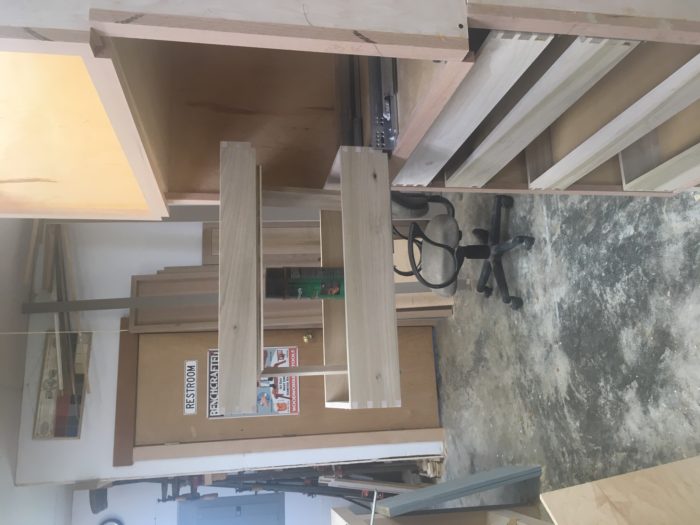
Each section would have its own interior fittings—drawers at the bottom, pullouts in the middle, and a shelf for the microwave and taller items at the top, left open for access to the original closet light and an electrical receptacle for the microwave—but all of the drawer and door faces would be made from a single sheet of high-grade veneer-core plywood faced in plainsawn red oak, with the grain continuous throughout. To preserve the match I would have to pay attention; a single screw-up on any element would probably mean replacing the whole sheet. Beyond that, to match the original cabinets I was going to edge each door or drawer front with solid cherry, mitering the corners and routing a radius with a router. An error at any later stage would mean duplicating a lot of labor, which can be disastrous when the work is your livelihood.
Then there were the pulls. I’ve made L-shaped pulls for a few Mid-Century-style kitchens, but on my first visit to the job site, which is in the forest (and so, relatively dark), I didn’t even notice that the pulls on the original cabinets have a strip of inlay.
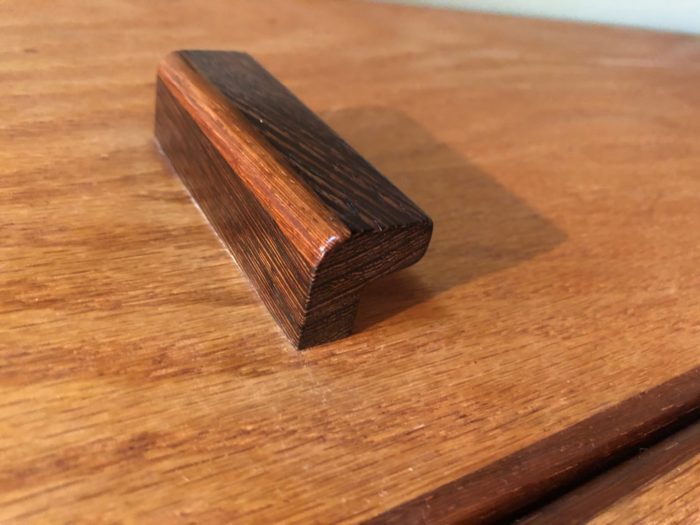
It was a simple detail, but one I’d have to figure out how to produce safely.
Here’s how I made these pulls
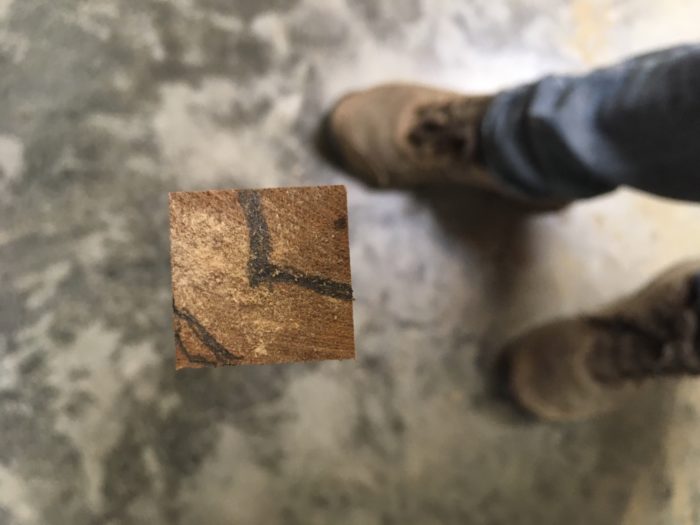
To start, I cut the bevel at the front corner on the tablesaw.
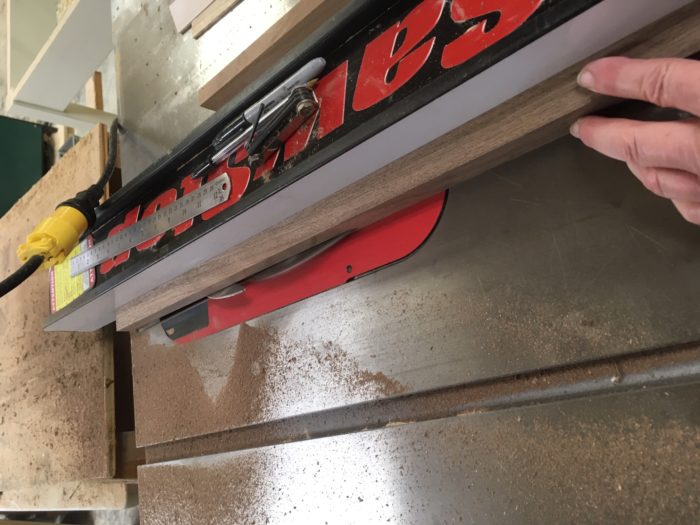
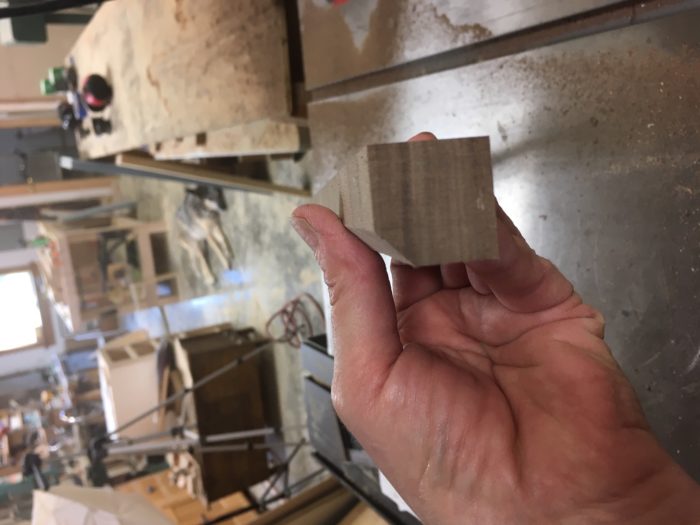
Next, I ripped small strips of cherry a little over the width and thickness of the bevel, in case of movement during the glue-up.
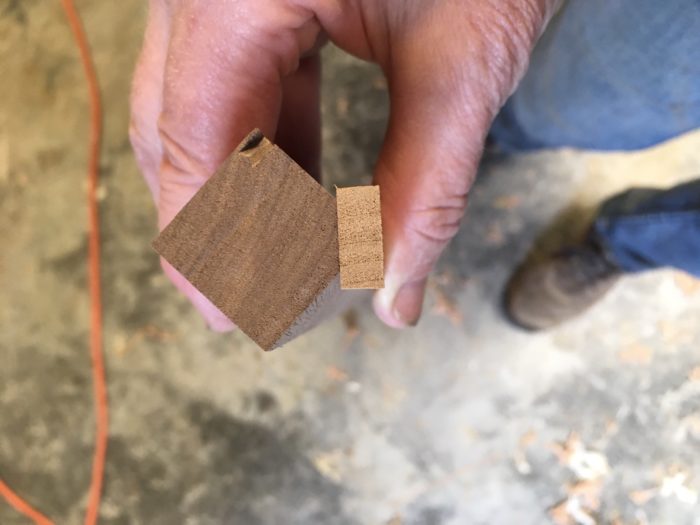
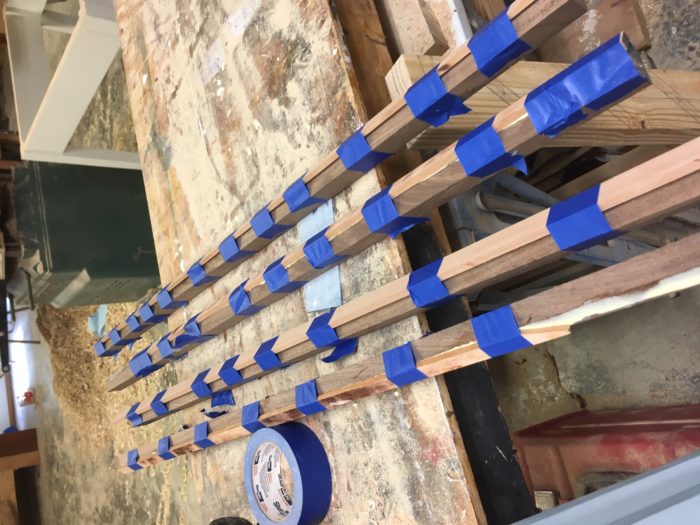
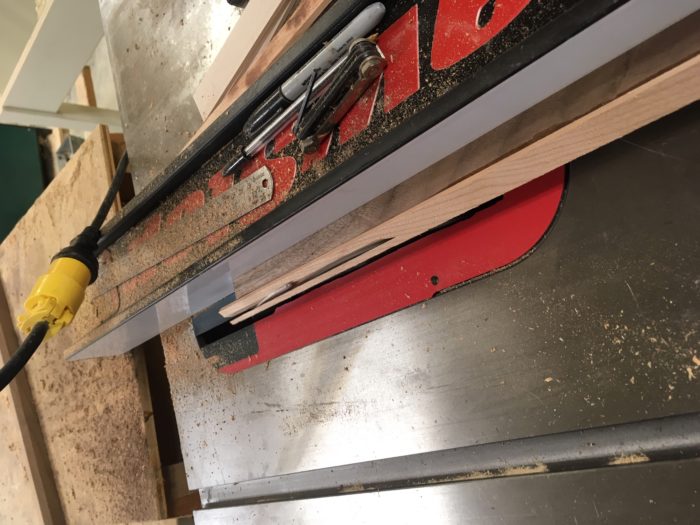
After that, it was a simple matter to radius the cherry corner with a router (I used a radius bit with a bearing, because my router table was still underneath a pile of stuff for another job).
To finish, I cut the square leg of the rabbet on the tablesaw with the riving knife removed. I followed that with the one that’s slightly beveled.
Another challenge involved the pullouts. Jeff had specified a pair, side by side, each of which would have two tiers. I was concerned that the contents of the lower section would be hard to see and hard to reach; when I made a mock-up, this concern proved valid. The whole point of this pantry retrofit was to make things more user-friendly, so I wanted to come up with something better.
After much insomnia-fueled pondering in the middle of one night, I recalled that my pal Bruce Chaffin (@brucephl on Instagram) had built most of his base cabinets with a secondary drawer inside of the primary one, giving him and his wife, Jana Moore, an additional level of storage capacity they could access independently of the main one. Ingenious! Jeff approved the suggestion, and I modified the interior of the middle case accordingly. (Bruce and Jana’s striking kitchen is one of the case studies in my new book, Kitchen Think.)
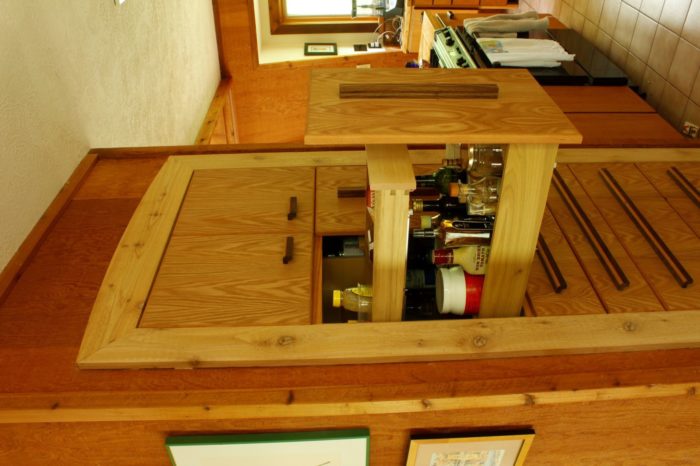
Installing custom-made pulls that have a thin face for attachment with screws is always hair-raising for me. I installed these with the aid of a TP-1935 cabinet hardware jig.
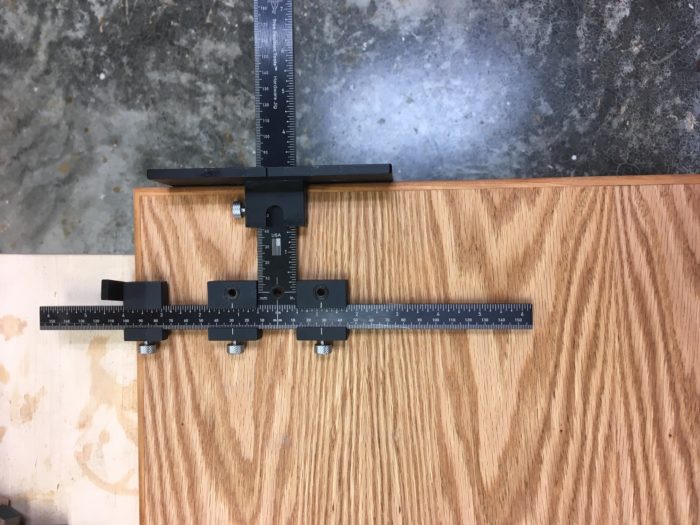
I left the vertical pulls for last, because Jeff had decided he wanted them inlaid with a random wave pattern and I was going to have to figure out how to produce it.
Here’s how I made the wave-inlaid pulls
I made a template out of 1/2-in. plywood with a sinuous pattern long enough to rout both pulls in a single length of material. Jeff approved the pattern before I went any further.
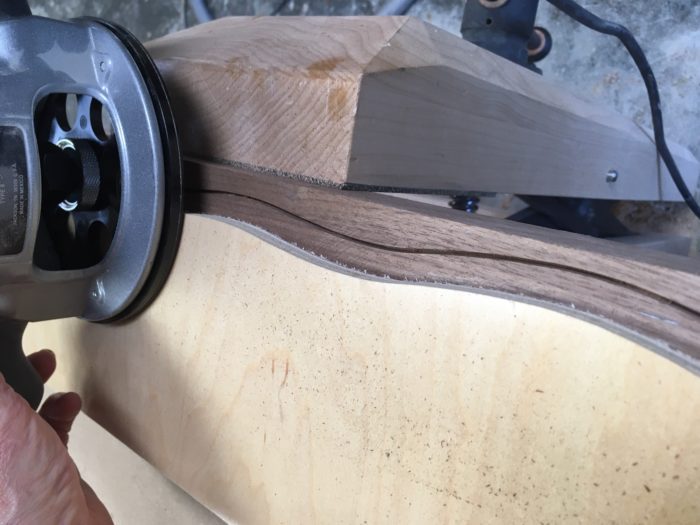
I used a router with a collar and a 1/16-in. cutter. Because I had only narrow pieces of walnut in the shop (wider stock would have made this easier), I left the stock as wide as possible and screwed the template to it at each end, in areas that would be waste. The stock was too narrow to hold clamps, but screws held it securely. I mounted the stock in the vise, high enough not to interfere with the router.
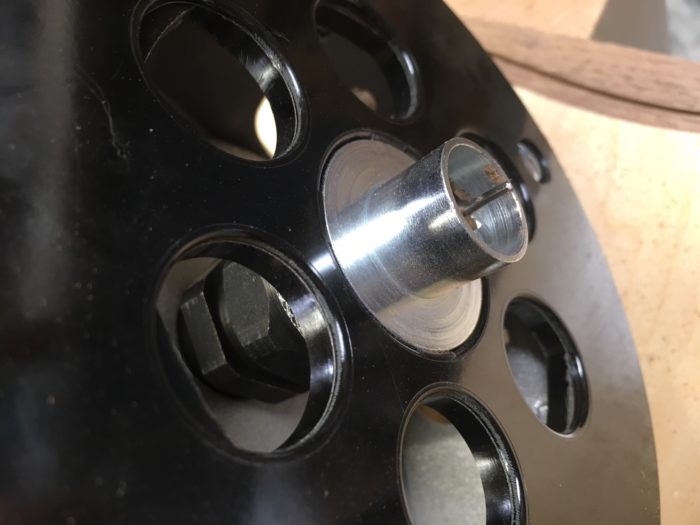

After routing the groove, I ripped the stock to width so that the inlay would be approximately centered. Then I ripped a strip of hard maple, using a push stick with a very skinny end (it took three tries to get just the right width) and glued it in, using a mallet. To make these pulls more ergonomic, I routed both sides with a shallow cove that provides a grip.
I am always nervous when the time comes for installation. In this case, I had built the cabinetry to fit snugly in the cased opening. But what if it should prove too snug? Fortunately, Jeff and I were able to slide it right in (with a little pushing). I leveled the base, and then we added the other sections. I returned after the weekend to install the roughsawn cedar trim, which I cut roughly to size and shaped at the shop. Everything about this piece will darken over time. (The finish is Watco “Natural,” as spec’d by Jeff.)
In sum …
Does this piece, with its red oak plywood, its knotty cedar trim, its mechanical drawer slides (I really don’t think I need to justify the use of Blum Tandem slides at this point, even in this venue—they’re the bomb), and its adjustable “European” hinges (which, by the way, are a special variety recommended by Blum’s Customer Service Department to suit the special conditions of this application—the 32mm hole is 14mm from the edge of the door, instead of the usual approx. 1/8 in.) deserve to appear under the auspices of Fine Woodworking? I certainly think so. Here’s why.
- This blog is for professionals. I know from letters and comments that much of this post will ring true for many others.
- My customer is kind and appreciative; the job paid the same as any of the more refined jobs I do.
- The job challenged me in several ways. I learned a few new things and solved some problems, both of which are deeply satisfying. John Ruskin would approve.
- I made my client happy. As he prepared to get his checkbook, he mentioned that he’d spent the weekend arranging pantry contents in the cabinet’s parts. He made clear that he appreciated the work and said he looked forward to using the cabinet every single day.
Call me simple, if you must—I’ve found it’s certainly easier to be happy that way.

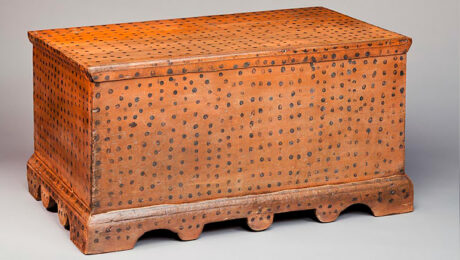

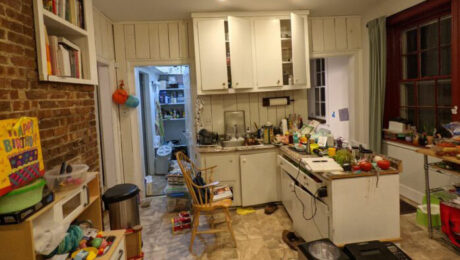
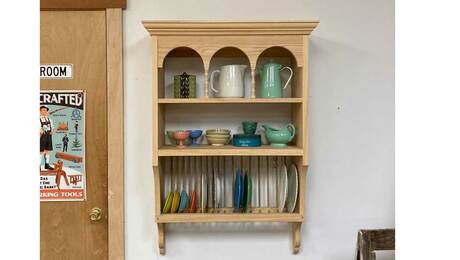


















Comments
Nice article Nancy and pretty pantry. Looking forward to your new book.
The while pecking order is quite silly. We have it in science (my day career; nights and weekends I woodwork) as well. I like to think Mike Rowe and Dirty Jobs helped to elevate jobs that might have been looked down upon.
I agree about the slides. I see nice professionally made furniture with side mount drawer slides and they just look out of place with so much metal showing. Why use side mount slides when you can use undermount slides and your drawers will look a lot cleaner. Nice job.
Beautiful work. Love those wavy inlay handles. I was asking for a close-up then realized they were the top pic...
Great article. I mainly build very expensive Craftsman furniture, but I'll do a built in anytime. They're not too difficult and it's good money. I just did a single plywood shelf insert for a clients tv nook in their living room.
I'm grateful for every job and nothing is beneath me.
Nice job, Nancy. Your craftsmanship and mechanical ability shines. It was very thoughtful of you to share your techniques. You have been at your craft for quite some time (not as long as I have) but I hear something that I don't like to hear from a learned artist. As a creator, I feel that I go the creation design alone. Yes I do listen to the client, but the concept, the design, THE CREATION, is mine alone. A few years ago I designed and crafted a beautiful curved cabinet of some of the finest woods and veneers that I could gather. The man that I worked for had given me carte blanche to "Come up with a masterpiece". He asked if his girlfriend could (wink-wink) work with me in the design. It was a request of friendship, really. During the making of the piece, the woman would often stop into the studio, to "Check on the progress". I would show her the progression. Often she would say "But why not this? " I would explain to her why things were and why they were not. I fell in love with this piece, and felt that it was the finest piece that I had made in quite some time - I was very proud of myself. I called my client and told him that the piece was finished and that it could be delivered to his Manhattan pent house . The next day his girlfriend showed up to view the piece. The doors of the cabinet were curved and veneered with a beautiful curly, (yep), rosewood. The two center doors met, when closed, into a chevron pattern, with dramatic fashion. Upon entering the Gallery in front of my studio the girlfriend screamed that the doors were veneered wrong - that the chevron pattern was wrong, and that the stripes of the chevron should have been reversed. I told her that was not the was NOT the way I designed it. She screamed - Pointed her finger into my face and said "What do you mean YOU? I designed this piece! She left the studio, and slammed the door. I called my client, and told him what had transpired, and that I was distraught. He very calmly told me not to worry, and to please deliver the piece. His girl friend had some problems, and he would take care of her -I was not to worry. A few months later, the client called me, just raving about the piece, and that all of his friends that saw it thought that it was a piece of art= magnificent. He asked if he could come over- he wanted more pieces that I would make for him...... I laughed, and very quietly said good by to him. Nice piece, Nancy, YOUR designs are great!
Good stories and beautiful work! Jophis's story reminded me of Nancy's book which I recently finished. I'm a finish carpenter/remodeler just dipping my toes into the sea of fine woodworking, but the stories of irrational clients rang true and were so painful I almost put the book down. I'm glad there are enough good clients out there to keep you going. Jophis, can you give us a picture of the piece?
Hi Nancy,
Great article, and beautiful work on the pantry. I think you said it best when you said, "I am so beyond snobbery"... I agree. Work is work regardless of what it is made with. We should be appreciative of any custmer who comes to spend their hard earned money on our work. If the customer is happy with the work, and you enjoyed the project, then that should be good enough for anyone. If it isn't, it is their problem, not yours.
Jophis, thanks for your comment and for sharing that astonishing experience of your own.
I do feel compelled to reply to the following statement from your comment: "I hear something that I don't like to hear from a learned artist. As a creator, I feel that I go the creation design alone. Yes I do listen to the client, but the concept, the design, THE CREATION, is mine alone." My reply doesn't concern how you conduct *your* business, but your apparent feeling that my view of how I run *my* business is somehow overly modest, and so, in need of a correction in perspective. I don't hesitate to claim some designs as my own (when they are my own, though as Chris Schwarz always takes pains to point out, we are all influenced by the work of others, both historic and contemporary). I am always ready to acknowledge, with appropriate pride as a designer-craftsperson, the particular contributions I have made while working with clients to come up with a design.
However, in this case, the design really was the client's. He gave me a scale drawing of the front elevation, and after verifying measurements in the field, that's what I built. He specified the materials and finish. This is not even a design I would have come up with, especially in terms of the proportions. Sure, I discussed every detail with him and suggested a few tweaks, especially to the interior. And yes, I built the piece. But I would not have designed it.
I am an experienced and well-informed listener who doesn't hesitate to provide important critical feedback to her clients, then let them make their own decisions (up to a point) about how they would like me to proceed, because I am working for them. I am frankly honored that good people value my abilities and pay me well to make major pieces for their homes. I relish working *with* my clients to design furniture (whether freestanding or built-in) that will enhance their daily experience. For me, this collaboration is enormously meaningful and satisfying.
Log in or create an account to post a comment.
Sign up Log in